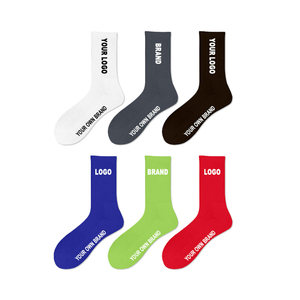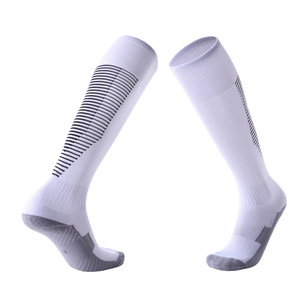(397 products available)
































































































































































































































Socks are foot coverings that are made from a blend of different materials like cotton, wool, nylon, polyester, and spandex. They exist in different sizes to fit various foot sizes. Chovm socks come in different shapes, sizes, and colors. Some socks are ankle-high, while others go past the calf or even the knee. They usually come in pairs, but single socks are also sold. Socks are used for different purposes, including comfort, warmth, and support. Socks can be thin or thick, depending on their purpose. For instance, sports socks tend to be thicker than dress socks. Here are their different types:
Athletic Socks
Athletic socks are designed to offer comfort, support, and protection when engaging in specific physical activities or sports. They are usually made to wick sweat and hence are made of synthetic materials like polyester, nylon, and spandex. Some of the socks are cushioned in areas where the feet make contact with the ground. There are different types of sports socks for different activities. For instance, running socks have additional cushioning in the heel and ball of the foot, while basketball socks have extra cushioning in the ankle and arch area.
Dress Socks
These socks are thin and have a tighter weave. They are made from materials like cotton, silk, or a blend of the two. They come in different colors, but they are generally conservative. For instance, black, navy, and brown are common colors for men's dress socks, while women's dress socks are usually more colorful and patterned. Despite being called dress socks, they are not as comfortable as casual socks.
Casual Socks
Casual socks are designed to be worn with casual clothing. They are available in various colors, patterns, and materials. They are usually thicker and coarser than dress socks. They are made from cotton, wool, and synthetic blends. Some casual socks have additional features such as arch support and cushioning.
Compression Socks
These socks exert pressure on the legs and feet. They are made from elastic materials that help promote blood circulation and reduce swelling. They are used by athletes to enhance performance and recovery and by individuals with medical conditions such as varicose veins and chronic venous insufficiency. They come in different compression levels, lengths, and sizes.
Diabetic Socks
These socks are designed to be worn by individuals with diabetes. They are made to reduce the risk of foot injuries and ulcers. They are usually non-binding, seamless, and cushioned. They are made from moisture-wicking materials to keep the feet dry and reduce the risk of infection.
Thigh High Socks
They are also known as over-the-knee socks. They are knee-length or longer and can reach the thighs. They are popular in women's fashion and are often worn with skirts and dresses. They add warmth and style to an outfit. They are made from cotton, wool, nylon, and spandex blends.
Toe Socks
These socks are also known as five-finger socks. They are designed to fit each toe separately, similar to a glove for the feet. They are made from cotton, wool, and synthetic blends. They are used for activities such as yoga, pilates, and toe running. They help improve grip and stability and reduce the risk of blisters between the toes.
Boot Socks
These socks are designed to be worn with boots. They are thicker and taller than regular socks to provide comfort and support for extended wear. They are made from wool, cotton, and synthetic blends. They have additional cushioning and arch support.
Novelty Socks
These socks are designed to be worn with boots. They are thicker and taller than regular socks to provide comfort and support for extended wear. They are made from wool, cotton, and synthetic blends. They have additional cushioning and arch support.
The socks are designed to be comfortable, stylish, and functional. Here's a breakdown of their design elements:
Natural Fibers
Natural fibers like wool, cotton, and bamboo are used to make socks because they are comfortable, durable, and moisture-wicking. Wool is especially great at keeping feet warm and dry, whereas cotton and bamboo are cool and breathable.
Synthetic Fibers
Synthetic fibers like nylon, polyester, and spandex add durability, elasticity, and moisture-wicking properties to socks. Nylon and polyester are durable and moisture-wicking, while spandex provides stretch for a snug fit.
Anatomical Fit
Anatomical fit refers to how well a sock conforms to the natural shape of the foot. A well-designed anatomical fit can improve comfort and reduce blisters by minimizing bunching and friction. Some socks are made with left and right foot-specific designs, while others may use 3D knitting techniques to create a more ergonomic fit.
Cushioning
Cushioning in socks provides impact absorption and support. It's typically found in high-pressure areas like the heel and forefoot. Different sock types use varying cushioning densities to cater to specific activities. For instance, running socks may have targeted cushioning to reduce fatigue and injury risk during long runs, while casual socks may offer lightweight cushioning for everyday comfort.
Arch Support
Arch support in socks helps maintain foot stability and reduce fatigue. It's beneficial for individuals with high or low arches, providing a supportive structure that aligns the foot and reduces strain on the muscles and ligaments. Some socks incorporate compression zones to offer graduated support that enhances blood flow and reduces swelling during prolonged standing or walking.
Seamless Design
Seamless socks eliminate traditional sock seams to reduce friction and irritation. This design is particularly beneficial for individuals prone to blisters or skin sensitivities. By creating a smooth, uninterrupted surface against the skin, seamless socks enhance comfort and allow for longer wear without discomfort. Some seamless socks also incorporate strategic ventilation zones to improve breathability and moisture management.
Moisture-Wicking
Moisture-wicking socks draw sweat away from the skin to the sock's outer layer for evaporation. This keeps feet dry and reduces friction, minimizing blister risk. Effective moisture management enhances comfort and foot health during prolonged wear, especially in active or humid conditions.
Temperature Regulation
Temperature-regulating socks use materials and construction techniques to adapt to changing foot temperatures. Natural fibers like wool and bamboo wick moisture and provide insulation, while synthetic blends offer breathability and moisture management. This dynamic response helps maintain a stable foot temperature, reducing overheating and coldness. As a result, temperature-regulating socks enhance comfort and prevent fatigue during extended wear in varying environments.
Compression
Compression socks apply graduated pressure to the foot and lower leg to improve circulation and reduce swelling. They are used for recovery, travel, and medical purposes. By enhancing blood flow and lymphatic drainage, compression socks help reduce fatigue, prevent varicose veins, and promote faster recovery after exercise or prolonged standing. They are also beneficial for individuals with circulatory issues or those who spend long hours on their feet daily.
Durability
Durable socks are made with high-quality fibers like nylon, merino wool, and polyester. Reinforced areas, advanced weaving techniques, and moisture-wicking properties enhance longevity and performance. These features ensure the socks withstand wear and tear, maintain comfort, and provide support for extended use in various activities and environments.
Casual Outfits
Chovm socks can be matched with casual outfits. For example, sneakers can be paired with ankle socks. This combination is ideal for daily activities. It provides comfort and style. Long socks can be worn with shorts. This look is trendy and casual. It is suitable for warm weather. Patterned socks add interest to a simple outfit. Stripes or polka dots can enhance jeans and a t-shirt. They bring a fun element to casual wear. Colorful socks can be a statement piece. They can contrast with the rest of the outfit. This approach shows a bold fashion choice. Layering socks is another option. Wearing two pairs with different lengths and colors is unique. It demonstrates creativity in styling. Overall, socks offer versatile styling possibilities for casual outfits.
Formal Outfits
Matching socks to formal clothing requires attention to detail. Neutral-colored socks pair well with business attire. They complement a suit or dress pants. Black socks with a black suit are classic. They provide a sleek look. Brown socks match earth tones. They work well with brown or tan suits. Navy socks pair with blue suits. They maintain a cohesive color scheme. Dress socks should be long. They stay up and cover the calf. This keeps a polished appearance. Avoid white socks with formal wear. They are too casual for business settings. Instead, opt for darker or neutral tones. Patterned socks can be used carefully. Subtle designs like stripes or dots are acceptable. They add interest without being flashy. Bold patterns are less suitable. They may distract from the overall outfit. Remember, socks should enhance, not overpower, formal attire.
Sporting Outfits
Matching socks to sportswear enhances comfort and performance. For running, choose lightweight, breathable socks. They prevent blisters and keep feet cool. Opt for brands known for athletic gear. They offer socks designed for specific sports. For basketball, high-cushion socks provide support. They absorb impact and reduce fatigue. Look for socks with moisture-wicking properties. They keep feet dry during intense games. For soccer, consider compression socks. They improve circulation and support muscles. This can enhance endurance during matches. Colorful socks can match team uniforms. They show team spirit and unity. However, prioritize function over fashion. Socks should fit well and stay in place. Avoid socks that slip or bunch up. They can distract from performance. Remember, the right socks make a difference in sports. They support the feet and body. This allows athletes to focus on their game.
Q1: What are the main types of socks available on Chovm?
A1: Socks come in various types, including ankle socks, crew socks, knee-high socks, no-show socks, and athletic socks. Each type serves a specific purpose and fits different footwear styles.
Q2: Can custom sock designs be made?
A2: Yes, many suppliers on Chovm offer customization options. Buyers can add their logos, patterns, or colors to create unique branded socks.
Q3: What materials are socks made of?
A3: Socks are crafted from diverse materials like cotton, wool, polyester, nylon, and bamboo. Each material offers distinct benefits in terms of comfort, durability, and breathability.
Q4: Are there sustainable sock options?
A4: Yes, sustainable socks made from organic cotton, bamboo, and recycled materials are available. These options promote eco-friendly practices and reduce environmental impact.
Q5: What sizes of socks are offered?
A5: Socks come in various sizes, from small to extra-large, to accommodate different foot sizes and ensure a comfortable fit for men, women, and children.